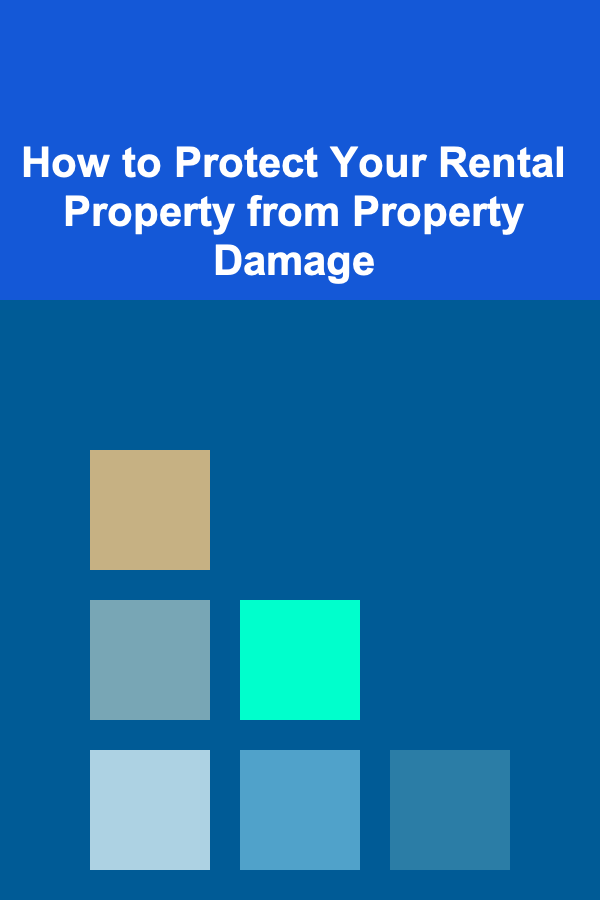
How to Protect Your Rental Property from Property Damage
ebook include PDF & Audio bundle (Micro Guide)
$12.99$9.99
Limited Time Offer! Order within the next:

Owning rental property can be a lucrative investment strategy, but it also comes with its fair share of challenges. Among the most significant concerns for landlords is the protection of their property from damage caused by tenants, weather, or other unforeseen factors. Property damage can lead to costly repairs, decreased property value, and even legal disputes with tenants. Therefore, landlords must take proactive measures to safeguard their rental properties.
This article will explore various strategies that landlords can employ to protect their rental property from damage. These strategies span from tenant selection and lease agreements to regular property inspections and appropriate insurance coverage. The goal is to provide actionable steps that landlords can take to minimize the risk of property damage and maintain the value of their investments.
Tenant Selection and Screening
One of the first and most important steps to protecting your rental property is ensuring that you choose reliable tenants. While no tenant is perfect, thorough screening can help you minimize the risk of property damage by identifying responsible individuals who are more likely to treat your property with respect.
A. Tenant Screening Process
The tenant screening process involves assessing the applicant's rental history, financial stability, and personal background. Several key factors should be considered during this process:
- Credit History: A good credit score is an indicator of a tenant's financial responsibility. Tenants with a strong credit score are more likely to pay rent on time and maintain the property in good condition.
- Rental History: Speak to previous landlords to gauge the applicant's behavior as a tenant. Were there any complaints about property damage, late rent payments, or failure to follow lease terms? This information is crucial in identifying potential risks.
- Income Verification: Ensuring that the tenant earns enough to cover the rent is important not only for financial stability but also because tenants under financial strain may be more likely to neglect property maintenance or avoid paying rent for repairs.
- Criminal Background Check: While conducting criminal background checks is important for security reasons, it can also indicate if a potential tenant might pose a risk to the property. Tenants with a history of violence, theft, or vandalism might be more likely to damage the property.
B. Set Clear Expectations in the Lease Agreement
Once you've chosen the right tenant, the next step is to set clear and reasonable expectations regarding property maintenance. A well-drafted lease agreement is a powerful tool in protecting your rental property. Here are key elements to include in the lease agreement to minimize the risk of property damage:
- Maintenance Responsibilities: Clearly outline the tenant's responsibilities regarding property upkeep. This might include tasks such as lawn care, replacing lightbulbs, and cleaning gutters. Emphasize the importance of reporting any maintenance issues promptly.
- Damage Repair: State that tenants are responsible for any damage they cause to the property, including accidental or negligent damage. Explain the process for handling damage claims and the procedure for repairs.
- Property Alterations: Specify whether tenants are allowed to make changes or improvements to the property, such as painting walls or installing shelves. Require written permission for any alterations to ensure that the property remains in good condition.
- Security Deposits: Include details about the security deposit and the conditions under which it may be withheld at the end of the lease. The security deposit acts as a financial safeguard for damage or excessive wear and tear.
C. Conduct Regular Tenant Inspections
Regular inspections are essential to monitoring the condition of your rental property and identifying potential issues before they become major problems. A proactive inspection strategy can help identify damage caused by tenants early and prevent it from escalating.
- Routine Inspections: Schedule regular inspections, typically every 6 to 12 months, to ensure that the property is well-maintained. During these inspections, check for signs of damage, leaks, or misuse.
- Move-In/Move-Out Inspections: Conduct a thorough inspection when tenants move in and move out. This allows you to document the property's condition at the start and end of the lease term. Taking photos during these inspections can provide valuable evidence in case of disputes over damage.
Property Maintenance and Upkeep
An ounce of prevention is worth a pound of cure, and this is particularly true when it comes to property damage. Regular maintenance and timely repairs can help prevent minor issues from turning into major, costly problems. As a landlord, maintaining the property is your responsibility, and it is crucial to stay ahead of maintenance tasks to preserve the property's value and condition.
A. Routine Property Maintenance
Developing a maintenance schedule is one of the most effective ways to prevent property damage. This schedule should cover regular inspections of essential systems, such as plumbing, electrical, and HVAC. Here are some key areas to focus on:
- Roofing: The roof is one of the most important components of your property's structure. Regularly inspect the roof for damage, leaks, or worn-out shingles. A damaged roof can lead to water leaks, mold growth, and extensive interior damage.
- Plumbing: Plumbing issues, such as leaky pipes or clogged drains, can cause significant damage if left unaddressed. Regularly check for signs of water damage, mold, or rust. If the property is located in an area with freezing temperatures, ensure that pipes are insulated to prevent bursts in cold weather.
- Electrical System: Faulty wiring or outdated electrical systems can pose fire hazards. Hire a licensed electrician to inspect and update the electrical system as needed. Be sure to check that smoke detectors and carbon monoxide detectors are functional.
- HVAC Systems: Regular maintenance of heating, ventilation, and air conditioning systems will extend their lifespan and prevent costly breakdowns. Change filters regularly and schedule annual inspections to ensure the systems are working efficiently.
- Landscaping: The exterior of the property is just as important as the interior. Overgrown trees or shrubs can cause damage to the roof or foundation. Maintain the landscaping and address any safety hazards, such as uneven walkways or steps.
B. Use High-Quality Materials
Using high-quality materials during the construction or renovation of the property can help prevent damage and reduce the need for frequent repairs. Invest in durable flooring, weather-resistant paint, and long-lasting appliances. Though the upfront cost may be higher, the long-term savings from fewer repairs and replacements will make it worthwhile.
C. Respond Quickly to Tenant Repair Requests
When tenants report maintenance issues, address them promptly. Ignoring or delaying repairs can lead to more significant damage down the road. It's important to have a system in place to manage repair requests efficiently. Consider the following strategies:
- Clear Communication: Make sure tenants know how to report issues, and ensure they understand the urgency of addressing maintenance requests promptly.
- Reliable Contractors: Establish relationships with trusted contractors and maintenance personnel who can respond to emergency repair requests quickly. This will reduce downtime and prevent damage from worsening.
- Emergency Repairs: Have a contingency plan in place for emergency repairs, such as water leaks or broken heating systems. Consider providing tenants with a list of emergency contacts in case repairs are needed outside of regular hours.
Legal and Insurance Protection
While preventative measures and maintenance will help protect your property, accidents and unforeseen circumstances may still occur. Therefore, it is important to have legal and insurance protections in place to safeguard your rental property.
A. Landlord Insurance
Landlord insurance is essential for protecting your property from financial loss caused by damage or other risks. Standard homeowner's insurance may not cover rental properties, so it's important to invest in a specialized policy that includes coverage for:
- Property Damage: This covers damage to the structure caused by fire, flooding, vandalism, or other covered events.
- Loss of Rent: If the property becomes uninhabitable due to damage, landlord insurance can help cover lost rental income.
- Liability Protection: This protects you in the event that a tenant or visitor is injured on the property and decides to sue.
Before purchasing insurance, review the policy carefully to ensure it provides the coverage you need. Consider adding extra coverage for high-risk events, such as natural disasters or flooding, if relevant to your property's location.
B. Liability Waivers and Tenant Insurance
While landlord insurance protects the property itself, tenants should also be encouraged to obtain renter's insurance. Renter's insurance covers the tenant's personal belongings in case of damage or loss. In addition to recommending renter's insurance, landlords may consider requiring tenants to obtain insurance as part of the lease agreement.
Including a liability waiver in the lease agreement can also protect you from being held liable for property damage caused by tenant negligence. However, it's important to note that a liability waiver does not absolve landlords from their responsibilities to maintain a safe living environment.
C. Disaster Preparedness
Ensure that your property is prepared for natural disasters or severe weather events. Depending on the location of your property, this may include:
- Flood Insurance: If your property is located in a flood zone, it's crucial to have flood insurance in place. Standard landlord insurance does not typically cover flood damage.
- Hurricane or Earthquake Preparedness: In regions prone to hurricanes or earthquakes, take steps to reinforce the structure and minimize damage, such as installing storm shutters or reinforcing the foundation.
Conclusion
Protecting your rental property from damage is a multi-faceted endeavor that requires proactive planning and ongoing attention. By carefully screening tenants, maintaining the property, and investing in the right insurance, landlords can minimize the risk of damage and preserve the long-term value of their investment. Remember, being a responsible landlord means staying ahead of potential issues and creating a safe, well-maintained environment for your tenants.
By taking these preventative measures, you can safeguard your property, avoid costly repairs, and ensure that your rental business remains a profitable and sustainable venture for years to come.
Reading More From Our Other Websites
- [Organization Tip 101] How to Curate a Capsule Wardrobe with Luxury Pieces
- [Home Budget 101] How to Reduce Home Energy Costs: Simple Fixes for a More Efficient Home
- [Needle Felting Tip 101] Troubleshooting Common Mistakes When Needle Felting Feline Features
- [Digital Decluttering Tip 101] Living Light Online: Strategies to Cut Screen Time Without Missing Out
- [Personal Financial Planning 101] How to Prepare for a Comfortable Retirement in Your 30s
- [Home Soundproofing 101] How to Soundproof a Home Office on a Budget
- [Home Budget Decorating 101] How to Decorate Your Home with Inexpensive Throw Pillows and Blankets
- [Organization Tip 101] How to Organize Dress-Up Clothes for Imaginative Play
- [Home Rental Property 101] How to Select an Apartment with a Pool for a Perfect Summer Rental
- [Home Budget 101] How to Budget for Senior Home Care Needs and Unexpected Expenses

Top Tips for Saving Money on Baby Diapers and Wipes Without Compromising Quality
Read More
How to Use Movement for Mindful Connection
Read More
Developing Your Leadership Philosophy: A Comprehensive Guide
Read More
10 Tips for Handling Legal Documents on Your Separation To-Do List
Read More
10 Tips for Financing a Luxury Vehicle: Options & Strategies
Read More
10 Tips for Mastering Form W-9: A Comprehensive Guide
Read MoreOther Products

Top Tips for Saving Money on Baby Diapers and Wipes Without Compromising Quality
Read More
How to Use Movement for Mindful Connection
Read More
Developing Your Leadership Philosophy: A Comprehensive Guide
Read More
10 Tips for Handling Legal Documents on Your Separation To-Do List
Read More
10 Tips for Financing a Luxury Vehicle: Options & Strategies
Read More